Before and after photos on telescopic copings or telescopes for parallelism performed in our Smile Makeover office.
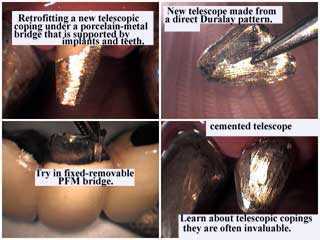
Retrofitting a new telescopic coping under a porcelain metal dental bridge. There are many uses for dental telescopes in periodontal prosthesis and full mouth oral rehabilitation. Read Telescopic Prosthetic Dentistry by Yalisove and Dietz.
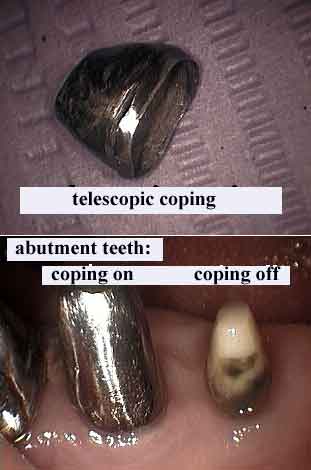
Telescopic Copings are also called telescopes. The coping is cemented with permanent dental cement to the abutment teeth. The dental prosthesis may then be cemented over it with a temporary dental cement. This allows a fixed-removable dental prosthesis without the possibility of recurrent decay.

Telescopic copings in implant dentistry. Telescopes may be used to create parallelism with dental implants. Some of the dentistry seen in this section may be dated but it is worth keeping online because it demonstrates the many uses of telescopic copings.
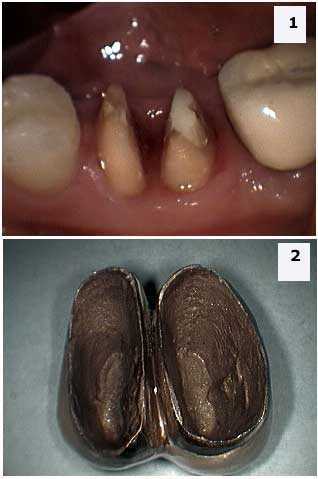
Dental crown design for a hemisected mandibular molar that involves a telescopic sleeve coping. 1) Photo of tooth #30 after hemisection. 2) Photo of the crown as seen from below to show a metal furcation and that it looks like two separate premolar crowns. This technique helps protect the tooth while simplifying abutment parallelism.
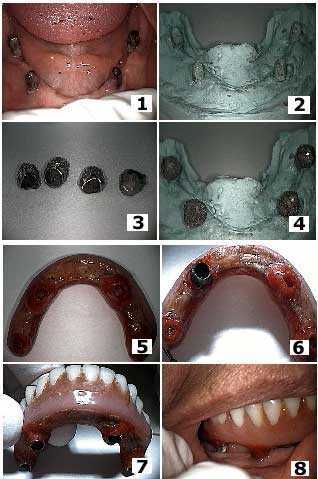
Retrofitting telescopic copings under an all-acrylic prosthesis over a full mandibular subperiosteal dental implant. This implant and prosthesis is over 15 years old. The all-acrylic prosthesis had been successfully retained with a small amount of denture adhesive over the dental implant abutments. The patient would return about twice a year to reline the acrylic of the prosthesis that would wear over time against the dental implant posts. The patient wanted to reduce the frequency of these relines. 1) Full mandibular subperiosteal dental implant. 2) Master model photo. 3) Four dental telescopic sleeve copings were fabricated to fit over the implant posts and had roughened outer surfaces for incorporation into the acrylic prosthesis. 4) The four telescopes on the master cast. 5) The underside of the all-acrylic implant prosthesis. 6) One coping being incorporated into the prosthesis at a time. The acrylic in the immediate area had been removed to allow the prosthesis to seat over the coping, then flowable self-curing acrylic was relined over it. 7) The prosthesis with all four copings attached. 8) An intraoral photo of the implant prosthesis with the telescopic copings attached.
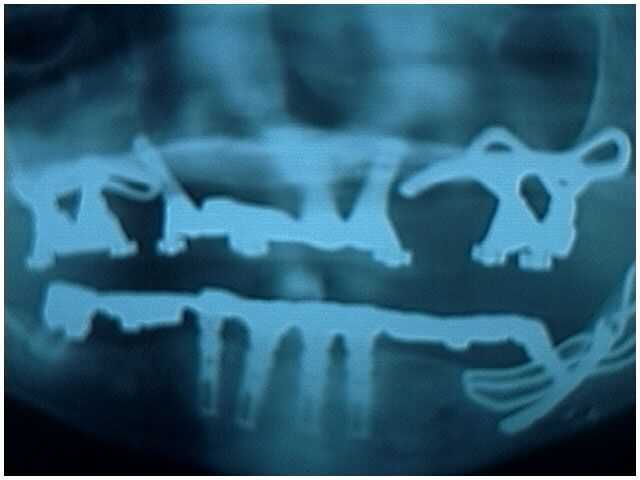
Combination of dental implants. Three unilateral subperiosteal implants (two upper and one lower) that vary in age from 5-16 years, seven anterior osseointegrated dental implants (three upper and four lower) that vary in age from 3-11 years, and one lower posterior molar with a telescopic coping that has remained intact for 16 years. This author personally practiced many years ago with Dr. Leonard Linkow and had first hand experience with many complicated but successful cases like this. In later years this author stopped his involvement with these types of implant cases because mainstream dentistry was headed in a different direction and the neophyte experts didn’t understand this kind of implant dentistry. Any serious student of implant dentistry should read the four Linkow textbooks provided for free in the Dental Textbooks section of this website. Leonard Linkow and the men of that era were geniuses.